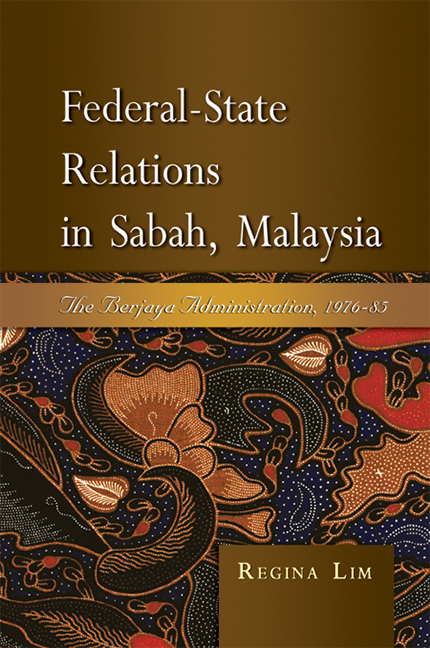Book contents
- Frontmatter
- Contents
- List of Tables and Figures
- Acknowledgements
- Abbreviations and Glossary of Terms
- 1 Introduction
- 2 Sabah Before Malaysia
- 3 Contesting the Rules of the Game, 1963–76
- 4 BERJAYA and Federal-state Relations
- 5 Development and Patronage
- 6 The Contest for Islamic Leadership and Multiracial Votes
- 7 Epilogue and Conclusion
- References
- Index
- About the Author
6 - The Contest for Islamic Leadership and Multiracial Votes
Published online by Cambridge University Press: 21 October 2015
- Frontmatter
- Contents
- List of Tables and Figures
- Acknowledgements
- Abbreviations and Glossary of Terms
- 1 Introduction
- 2 Sabah Before Malaysia
- 3 Contesting the Rules of the Game, 1963–76
- 4 BERJAYA and Federal-state Relations
- 5 Development and Patronage
- 6 The Contest for Islamic Leadership and Multiracial Votes
- 7 Epilogue and Conclusion
- References
- Index
- About the Author
Summary
INTRODUCTION
The BERJAYA party relied on the concept of ‘multiracialism’ to bring down the USNO regime in 1976. However, the idea was problematic for the BERJAYA party both at the Federal level and in Sabah itself. Initially, the concept of ‘multiracialism’ did not appeal to the other dominant pro-Islamic parties, such as UMNO and PAS, within the BN coalition. The BERJAYA party could not draw support from the majority of the Muslim electorate who were strong supporters of USNO in Sabah. This problematic situation for BERJAYA intensified with the advent of the Mahathir Administration at the Federal level, which increasingly moved towards Islamization.
ELECTORAL POLITICS: WHO GOT THE MUSLIM VOTE?
As Milne and Ratnam (1969) observed in their study of voting patterns in the 1967 State elections, the UPKO-USNO contest was expected to, and did, follow broadly ethno-religious lines, with Muslim bumiputera generally voting USNO, non-Muslim bumiputera voting UPKO, and the Chinese generally — although less consistently — voting SCA. However, it was less easy to advance a similar analysis for the 1976 State election, for two reasons. Firstly, BERJAYA was a new and untested party and it was thus not immediately clear how voters would take to it. Secondly, its espousal of ‘multiracialism clearly demonstrated, at least, the ambition to win votes from more than one community. It was in this latter respect that the initial BERJAYA line-up was notable for its prominent candidates from all the major ethnic and religious groups, including Kadazan Muslim convert Donald Stephens, Christian Kadazan Peter Mojuntin, Muslim Bumiputera Harris Salleh, Salleh Sulong, and Chinese Yap Pak Leong.
Unfortunately, ethnic distribution data such as that used by Milne and Ratnam is not available for the 1976 election. However, we can get an idea of the religious breakdown of the vote by looking at the ethnic distribution of the districts — for which census data is available — and comparing this with the aggregate votes received in the State constituencies within the respective districts. Typically, each district contained between two to four State constituencies. Figure 6.1 shows the relationship between the proportion of the population made up of the predominantly non-Muslim groups — the Kadazan, Murut and Chinese — and the proportion of the total vote for BERJAYA in all twenty-one districts.
- Type
- Chapter
- Information
- Federal-State Relations in Sabah, MalaysiaThe Berjaya Administration, 1976–85, pp. 103 - 125Publisher: ISEAS–Yusof Ishak InstitutePrint publication year: 2008

